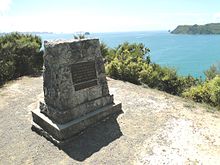Mercury Bay




Mercury Bay is a large V-shaped bay on the eastern coast of the Coromandel Peninsula on the North Island of New Zealand. It was named by the English navigator Captain James Cook during his exploratory expeditions. It was first named Te-Whanganui-a-Hei, the great bay of Hei, by the Māori.
On 9 November 1769 Cook landed on the shores of the bay to observe a Transit of Mercury. In 1919 an area of land around Shakespeare Cliff was set aside, and a small memorial was constructed, based on the erroneous notion that it was the location of Cook's observations.[1] But the actual site of Cook's landing and observation was the eastern end of Cook's Beach, near the Purangi estuary.[2] A smaller memorial plinth was established there also.
The brig Trial and the schooner Brothers were attacked by Māori on 20 August 1815 in Mercury Bay, when several sailors were killed.[3][4] The bay was the resting place of HMS Buffalo, a ship that transported passengers and prisoners to Australia that was wrecked in a storm in 1840.[5]
The mouth of Mercury Bay is ten kilometres across, and its coastline extends some 20 km. On the shore of the bay is the resort town of Whitianga, and a natural harbour is formed by an arm of the bay which extends inland a further six kilometres southward. Several small islets are located at the southern and northern extremities of the bay, and the Mercury Islands are 10 km to the north. The Whanganui A Hei (Cathedral Cove) Marine Reserve is in the southern part of the bay.
Named locations along Mercury Bay include Buffalo Beach, Wharekaho, Ferry Landing, Shakespeare Cliff, Lonely Bay, Flaxmill Bay, Cooks Beach, Purangi Estuary, Cathedral Cove and Hahei.
Mercury Bay is a good location for game fishing, with the Mercury Bay Game Fishing Club being one of the largest in New Zealand. The bay is also widely known for its yachting. The Mercury Bay Boating Club in Whitianga was the challenging club in New Zealand's first challenge for the America's Cup, in 1987.
There was an arched rock in Mercury Bay which collapsed. It was illustrated in the 1700s aboard James Cook's Endeavour. It was depicted with a pā on top of the rock.[6][7]
References
[edit]- ^ Bailey, Susan (1966). "Mercury Bay". In McLintock, A.H. (ed.). An Encyclopaedia of New Zealand. Retrieved 14 July 2019 – via Te Ara – the Encyclopedia of New Zealand.
- ^ Orchiston, Wayne (1994). "James Cook and the 1769 Transit of Mercury". Information Sheet. Carter Observatory: 3–4. ISSN 1173-7263. Archived from the original on 3 June 2010. Retrieved 30 December 2008.
- ^ "The Missionary Register". Early New Zealand Books (ENZB), University of Auckland Library. 1816. p. 523. Retrieved 9 March 2019.
- ^ "The Missionary Register". Early New Zealand Books (ENZB), University of Auckland Library. 1817. pp. 522–523. Retrieved 9 March 2019.
- ^ Heritage Department of the Auckland Regional Council. "Duder Regional Park – Our History" (PDF). Auckland Council. Retrieved 30 August 2021.
- ^ "Arched rock, Mercury Bay". teara.govt.nz.
- ^ "'... arched Rock, on the Coast of New Zealand; with an Hippa, or place of Retreat...'". Royal Society Print Shop. Retrieved 2 August 2023.
